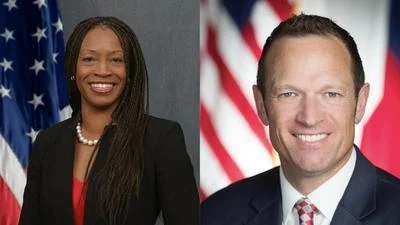The conservation programs administered by the U.S. Department of Agriculture began with good intentions. They were designed to help landowners increase agriculture production by efficiently using nature’s resources. They appealed to those in productive agriculture because proper stewardship of the land is essential to their livelihood. The condition of the land directly impacts the prosperity and condition of the landowner.
However, the Democratically controlled Congress changed the purpose for these programs when they passed the Inflation Reduction Act (IRA) in August of 2022. This change is allowing the Biden Administration to quietly stretch a regulatory web over America’s private lands.
The programs are promoted as “climate smart,” and for the purpose of helping the “working landowner” do more with their land. But these programs directly compete with the producer, artificially raising the price to lease or buy the land, and out price the working landowner. They have also become a slush fund for environmental non-profits who help implement the conservation restrictions.
The Conservation Reserve Program (CRP) that was originally designed to pay landowners to help create habitat by setting aside qualified parcels for a ten-year term, has now been redirected for the purpose of “mitigating climate change.”
The program that helps landowners make improvements to their lands, the Environmental Quality Incentives Program (EQIP), now prioritizes projects that control domestic livestock emissions. Specifically, the new language for these funds direct “prioritizing proposals … to reduce enteric methane emissions from ruminants;”… and …“projects and activities that mitigate or address climate change through the management of agricultural production, including by reducing or avoiding greenhouse gas emissions.”
Every dollar a landowner now takes under the latest appropriation is committing them to help carry out the extreme climate crisis agenda. It will be the government, not the landowner, that determines whether the enrollee is meeting that obligation.
Instead of helping agriculture be more competitive and productive, the programs create additional federal strings and justifications to regulate the private land uses, voluntarily agreed to by the landowner. Instead of a more independent food production system responsive to market needs, the American agriculture industry is moving into one controlled by the federal administrative state.
The Biden Administration is creating economic conditions where, to stay in business, America’s food producers are becoming more dependent on the “voluntarily” programs. This raises the question of whether the landowner’s enrollment is voluntary when administrative policies eliminate all other options.
On the surface, the change may appear to be nominal until you look at how the new language can strengthen the regulatory powers already held by the federal government.
For example, CRP already creates a federal nexus between the private land and laws such as the Endangered Species Act (ESA). With the new IRA purpose for the program being to mitigate climate change, the agencies are within their authority to require more consultations to ensure activities are not harming species listed in part because they may be impacted by climate change. This would be most of the species added to the federal protected list over the past 15 years.
Without this nexus, the ESA restrictions would not apply as Congress prevented this overreach when authorizing the Act. Anything less would have been an infringement on the constitutionally protected property rights. But when the landowner voluntarily enrolls in these programs, they are agreeing to the federal terms.
Under past administrations, the federal government had not exercised this power to its full potential. But today, with the Biden Administration insistent that Americans must permanently protect 30 percent of our lands and waters by 2030, the new language quietly slipped into the IRA signals the regulatory landscape is changing.
In 2020, environmentalists telegraphed this step would be essential to gain control of enough private lands to achieve 30x30 when they released the U.S. House Select Committee Report on the Climate Crisis. In the failed Build Back Better Act, Democrats added a separate appropriation to increase the funds specifically for ESA consultations, signaling they intended to do more.
Thankfully, the U.S. House of Representatives Agriculture Chairman, G.T. Thompson is aware of the environmental ruse, and has committed that the climate crisis language and any other attempt to implement 30x30, will not be advanced in the next round of conservation funding through the 2023 Farm Bill.
But these conservation programs are not the only vehicles landowners need to watch carefully to stop the advancement of 30x30. The House Select Committee report also stated that vehicles like CRP are just the first step to eventually move these lands into a perpetual conservation easement, their next big goal, where the land is promised to be protected from development forever.
This seems like a noble idea until you realize that the only activity the conservation easement limits or prevents is that of the landowner. It is the landowner that signs away the development rights to a land trust or government, who then retains the value of that easement on their balance sheet, while the landowner forever lives under the restrictions and oversight of the easement holder.
The landowner may receive an income tax deduction or estate tax reduction, but the next generation receives none of this. All they retain are the limited uses.
The government considers the land permanently protected because they now have oversight and can enforce the conservation purpose for the property forever. However, many easement enrollees are surprised to learn that the land can be condemned for a public purpose just as any other property, for projects such as a wind farm powerline or a carbon capture pipeline.
The hard truth is that the only activity or development the land is protected from is that of the landowner, and that is forever.
But there are some reasonable considerations that could be advanced that would push all these programs back into the category of good conservation measures. The first is to make sure the new climate crisis conservation language does not show up in future appropriations. Along with this, these programs could be excluded from the ESA consultation provision.
The second is to create a sunset on conservation easements, thirty years or less, so the next generation can decide the purpose of the land that is most beneficial to humans and nature. Land should be managed by the living, not the dead.
The third action would be to cut the funding of programs that go to environmental non-profits. The land trusts are using tax-payer dollars to convince landowners to sign up for the perpetual easements, which they directly benefit from. This has resulted in them becoming some of the most powerful entities in the world, and they use this influence to advocate for more power through unauthorized initiatives, such as 30x30, that work against American interests.
American taxpayers should not be paying to transfer more of our lands under the control of land trusts and the federal government. The federal, state, and local governments already own nearly 40 percent of our land base, and ironically, environmentalists say the cure to the “climate crisis” is to give them more.
It seems the prudent course would be to stop increasing the administrative state’s power over our land, and instead unshackle America’s landowners so they can steward our natural resources while feeding the nation and the world.









